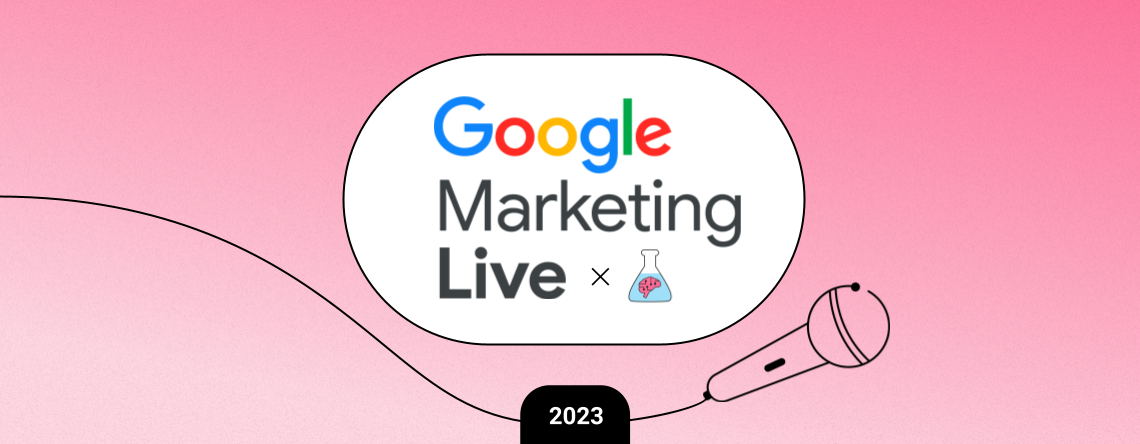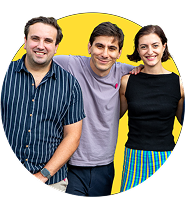Ever-changing realm
In the ever-changing realm of digital marketing, artificial intelligence (AI) has emerged as a transformative force. The recent Google Marketing Live event showcased Google’s commitment to leveraging AI for full funnel dominance. This document provides a concise overview of the groundbreaking announcements made at the event, highlighting the impact of AI on business growth, audience engagement, and campaign performance. From advanced features in Performance Max campaigns to strategic moves in mid and upper-funnel advertising, Google is pushing the boundaries of AI collaboration. This preface sets the stage for exploring the transformative potential of AI in the digital marketing landscape.
Redefining AI: from predictive tool to collaborative essential
| Topic | Page |
|---|---|
| Introduction | 03 |
| Performance Max | 03 |
| Video Updates | 05 |
| Redefining AI | 07 |
| Brainlabs Verdict | 08 |
| Conclusion | 09 |
The ‘AI Revolution’ and Google’s fight for the full funnel
At this year’s Google Marketing Live, Google announced new products and features with an emphasis on AI as a business game-changer, to bring them closer to full funnel dominance. Crucially, they are making huge strides in redefining AI from a predictive tool to a collaborative business essential.
So what was announced and what does it mean for you? We’re here to help you figure that out.
Introduction
Four brand new AI-powered features
What’s new?
Four key features to help improve results from PMax and address some of the recent feedback partners like Brainlabs have provided.
Performance Max (PMax)
Going further with goals
Google is leveraging AI to provide more goal options within PMax campaigns. This includes expanding the New Customer Acquisition (NCA) feature to optimise toward higher lifetime value customers as well as a raft of further goal settings focusing on existing customers.
What does this mean for brands?
Whilst the NCA feature has existed for some time this new addition allows us to differentiate new customers by their predicted lifetime value.
The increased options around re-engagement with existing customer bases shows Google’s acknowledgement of the importance in increasing retention, reducing churn, and driving profitability – a crucial addition for brands battling the current macroeconomic climate.
When’s it happening?
The NCA addition is set for the second half of 2023, while the Beta version for re-engagement will be available in Q4 of 2023.
Custom experiments
Multiple versions of campaign experiments have been released for PMax, often focusing on proving the value of PMax. However, this new functionality takes a different approach and runs on the assumption that PMax is already being utilized.
What does this mean?
This enables users to test various configurations of PMax campaigns against each other, more rigorously than we have been able to in the past.
Better insights
Following the search industry’s demand for transparency and deeper insights since the launch of PMax, Google is undertaking a revamp of the Search term insights report, expanding it to include additional categories and asset insights.
This enhancement will provide a better understanding of creative performance across different audiences.
What does this mean?
Armed with these insights, advertisers can make informed decisions about potential asset changes or refreshes.
Google will support this process by introducing two additional features: Firstly suggestions on assets that can improve performance and finally the ability to specify a lookback window when analysing performance. This comprehensive approach will empower advertisers to optimize their campaigns based on a more thorough understanding of asset performance and audience preferences.
Ease of use
PMax aims to simplify processes and enhance user experience by streamlining campaign management. As part of this, the Optimization Score component will be integrated into the campaign creation flow.
What does this mean?
When setting up a campaign, users will have access to pre-fills, options, and suggestions to ensure that campaigns are primed for success right from the start. The ultimate goal is to speed up campaign creation while maximising optimization. The release of both the Optimization Score and Campaign Prefills is planned for the second half of 2023.
Video Updates
Video view campaigns
What’s new?
Prioritizing view generation, this new, AI-powered campaign type operates on a cost per view buying model, integrating TrueView in-stream, In-feed, and Shorts ads into a single campaign.
What does this mean for brands?
This will help elevate brands to the forefront of consumers’ minds during their exploration phase providing the opportunity to showcase captivating creatives that drive consideration.
Google’s expectation is that it will deliver a notable increase in views (+40%) while reducing costs (-30%) compared to standard in-stream skippable cost per view campaigns alone.
When is it happening?
Currently available as an open Alpha campaign within Google Ads, it will soon be made accessible on DV360 as well.
Demand Gen is coming
What’s new?
Google is preparing to introduce a new campaign type called Demand Gen that will assist advertisers in effectively engaging and inspiring consumer actions through immersive, relevant, and visually compelling creatives that capture attention and deliver results precisely when needed. This campaign type boasts a range of unique features meticulously crafted to cater to the requirements of today’s social marketers.
What does this mean for brands?
Designed to exclusively reach consumers through visual and entertainment-oriented touchpoints like YouTube, Shorts, Discover Feed, and Gmail, this campaign ensures direct interaction as users stream, scroll, and connect, including a staggering 90% reach of Gen Z on Shorts. Google has plans to streamline the process of incorporating top-performing videos and image assets into the Demand Gen campaign, allowing advertisers to preview them seamlessly across various Google experiences. Moreover, Google will leverage AI-powered lookalike audiences to enable advertisers to extend their reach beyond their existing customer base and connect with new qualified audiences. Through Max-clicks bidding, advertisers will have the ability to optimize and measure campaign performance across the entire funnel, driving consideration goals such as site visits. Advanced measurement tools like Data-Driven Attribution, Brand/Search lift, and conversion lift will provide insights into the incremental impact generated by the campaigns.
Anticipated to be offered globally in Beta during the second half of 2023, the Demand Gen campaign will equip advertisers with a powerful solution to engage audiences, drive desired actions, and achieve their marketing objectives in a rapidly evolving digital landscape.
Redefining AI – from predictive to collaborative
It’s safe to say Google was explicit with its AI message. Google CBO Philipp Schindler said in the event’s intro, “AI is going to supercharge your ability to keep up with the speed, demands and unpredictability of consumers like never before, and we are here to put AI to work for your business”. So, how is this actually going to live and breathe? Read on!
AI Updates
What’s new?
Google Ads has embraced the power of AI by incorporating numerous AI features into advertising workflows. This goes beyond mere optimization and automation, as Google Ads now uses AI to surface valuable insights, generate scaled AI-powered creative content, and even introduce a revolutionary conversational interaction experience. With AI at the forefront, advertisers can unlock a wealth of data-driven insights enabling them to make more informed decisions.
The integration of AI-generated creative brings efficiency and scalability to the creative process, empowering advertisers to deliver compelling and personalized content at scale. Moreover, the introduction of conversational interaction with Google Ads introduces a new dimension of user engagement and opens up opportunities for more interactive and personalized advertising experiences. By integrating AI across its platform, Google Ads is revolutionizing the advertising industry and empowering advertisers to achieve remarkable results.
Brainlabs verdict
The Brainlabs view
What’s clear this year is that Google is taking a more combative stance against other media partners. With the release of Video View & Demand Gen campaigns, Google is clearly staking more of a claim for the mid & upper-funnel, in direct opposition to social platforms such as Facebook, Instagram & TikTok. Meanwhile, the slew of updates in PMax and Search show that they’re by no means losing focus on the lower funnel.
Here is our interpretation of how Google’s new releases will combine to cover the full customer journey – and how these products align to the offerings of other media players.
Channel prioritization & media competitor framework
- Video View
- Demand Gen
- PMax
- Pure Search
Video View campaigns cater to the exploratory phase, targeting a social audience primarily for the purpose of raising awareness. This campaign type can be seen as a direct competitor to platforms like TikTok and Instagram, focusing on capturing users’ attention rather than expecting deep engagement.
In contrast, Demand Gen campaigns aim to drive higher engagement levels, positioning them slightly lower in the marketing funnel. The inclusion of Discovery and Gmail within the campaign’s reach allows for a broader touchpoint with users as they stream, scroll, and connect.
This latest round of announcements has already got us thinking about some seriously weighty strategic questions, and how they apply to the world of performance marketing, and beyond.
We’ll finally be able to test – at scale – whether targeting new customers genuinely is more incrementally effective than spreading our budget across both new and existing customers.
In conclusion
These new products and features will further enable marketers to utilize AI-driven solutions to fuel business growth, enhance performance, and engage audiences across diverse digital channels.
With the recent surge in generative, large-language AI models, such as Google Bard and ChatGPT, the efficacy of the current search model has come under scrutiny by many business leaders who are seeking to leverage AI as a business multiplier (The Impact of Generative AI on Search Advertising).
The question arises: will the traditional Search Engine Results Page (SERP) maintain its dominant position in online query response, or will chatbots facilitating more personalised conversations overthrow its reign in the years to come?
However search will change in the coming years, one fact remains constant: people want an efficient means of accessing information online. As we wholeheartedly embrace AI as a business multiplier, at Brainlabs we remain confident in our collaboration with Google, a pioneering force in the digital search ecosystem.
Together, we know we will continue to harness the potential of AI to drive transformative growth, unlock new opportunities, and deliver unparalleled value to our clients and partners.
Thanks to our Brainlabs expert contributors from across the globe
- Jeremy Hull
Chief Product Officer, NAMER - Alessandro Creso
VP of Paid Search, NAMER - Andy Goodwin
Head of Paid Search, UK - Gyn Ang
APAC SVP - Leo Jennings
UK SVP, GROWTH - Rachelle Risner
VP, NEW BUSINESS
Get in touch
- Gyn Ang
APAC SVP
gyn.ang@brainlabsdigital.com - Leo Jennings
UK SVP, GROWTH
leo@brainlabsdigital.com - Rachelle Risner
VP, NEW BUSINESS
rachelle.risner@brainlabsdigital.com
brainlabsdigital.com
APAC EMEA North America
Follow us for more great insights!



